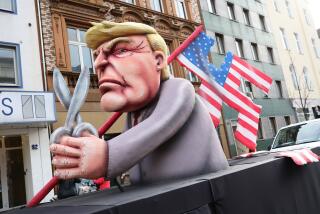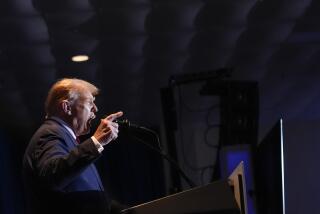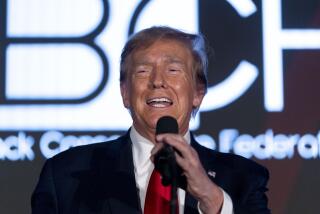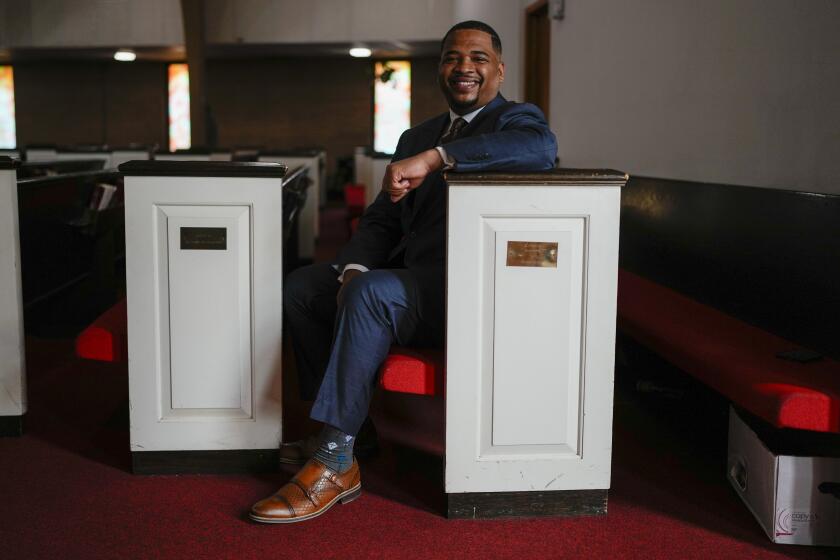Analysis: At Trump’s bully pulpit, it’s ‘us’ vs. ‘them,’ with race often used as a device to polarize
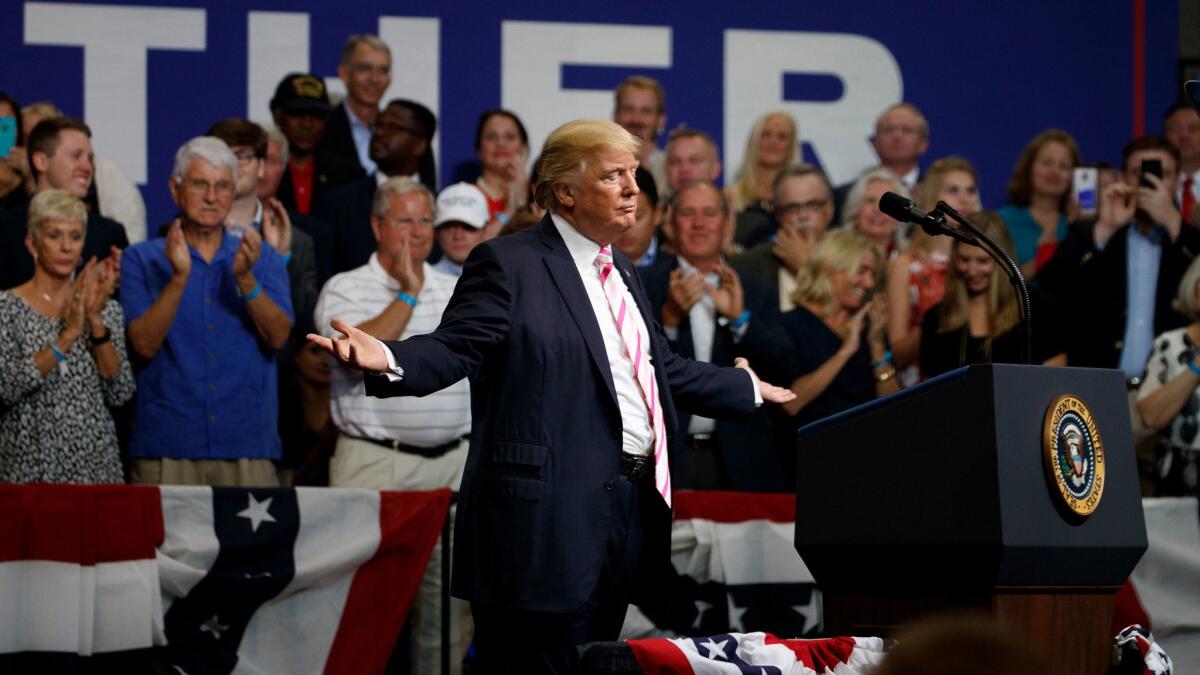
For much of his time as president, Donald Trump has been the bully at the bully pulpit, castigating targets foreign and domestic. Much of Trump’s bluster attempts to divide people into us-against-them, and it often has a single polarizing agent: race.
On Friday night, as he has many times before, Trump inflamed an almost exclusively white Southern audience against opponents who he said were trying to steal their heritage and attack their values. In that Alabama speech and on Saturday, he criticized African American athletes who had exercised free speech by declining to stand during the national anthem.
His racially oriented statements seem to reflect Trump’s embrace of the world as it was decades ago when power was largely held by men like him.
By the sheer bulk of his comments, Trump has reversed what had been a trend in politics over several decades: racial appeals have grown less overt, not more. Trump’s targets in the last week, by contrast, have included Golden State Warriors star Stephen Curry, unemployed NFL quarterback Colin Kaepernick and ESPN anchor Jemele Hill — all African Americans.
Although the president also targeted whites, such as Republican Sen. John McCain of Arizona, those disputes involved policy matters, not the sort of highly personal judgments he made about the three sports figures.
For Trump, race has been integral to his political aspirations.
He led a public campaign for the death penalty to be imposed in the case of the “Central Park 5,” five black and Latino teenagers accused of raping a white woman, and did not relent even after DNA evidence and a confession by another man led to their exoneration. He built his presidential campaign on a fierce effort to prove that the nation’s first African American president was not a citizen of the country he led.
Trump jumped into the presidential contest by flinging insults at Mexicans. During his campaign, he cast doubt on the allegiance of Muslims, accused people in China and Japan of taking American jobs, and over and over castigated immigrants.
The point appeared to be to encourage a surge of white pride that would draw voters to him — and to a large extent it worked. Now, as president, Trump is continuing in the mold he made as a candidate.
“Trump is specifically trying to run on a strategy of mobilizing whites,” said Stephen A. Nuno, a political science professor at Northern Arizona University in Flagstaff. “It’s not coalition building. It’s identity formation.”
Both of his slogans — “Make America Great Again” and “America First” — carry insinuations of race and culture. The first suggests a return to a time when nonwhites, as well as women, were locked out of the power centers of America, whether business suites or the Oval Office. “America First” was used by opponents of the U.S. entrance into World War II, some of whom expressed strongly anti-Semitic views.
Divining the intent of any politician’s remarks, or the audience’s receipt of them, can be complicated. Who doesn’t want America to be great? Who doesn’t want values protected? Not all Trump supporters were drawn in by his racial views, although by this point he has made them clear.
Political messages are refracted through individual lenses, and often unwittingly rely on deep-seated assumptions and biases, according to social scientists. For example, Trump’s regular calls for an imposition of law and order may seem reasonable to an audience of white supporters fearful of crime and of criminals they presume to be nonwhite. To others in nonwhite communities fearful of law enforcement, Trump’s words seem to give license to abuse by police. Similar pitches on topics such as welfare, immigration, gay and transgender rights and women’s rights may sound one way to Trump’s supporters, and the opposite to others.
Research has shown that remarks based on race can be even more powerful in difficult economic times — a circumstance that prevailed in many states during last year’s election.
For decades, politicians of both parties have danced carefully around the line to send signals to various demographic groups.
It was no accident that Ronald Reagan opened the last sprint of his 1980 election campaign in Philadelphia, Miss., near where three civil rights workers had been killed a generation before — and that he uttered the segregationist slogan “states’ rights” during his speech. It was no accident that Bill Clinton, during his first campaign for president in 1992, made a big show of his intent to reform welfare.
Both, it was argued, were highlighting policy matters, and both denied any racial intent. But both also were delivering a message — Reagan, that he sympathized with southern Republicans on whom campaigns to expand civil rights guarantees grated; Clinton, that he was not a stereotypical liberal Democrat.
“That coded language is very important,” Nuno said. “It establishes legitimacy with the crowd. It helps sooth concerns that the candidate may betray the group.”
The closest comparison to Trump in recent decades may be the former Democratic governor of Alabama, George Wallace. In his presidential campaigns, Wallace was stylistically similar to Trump in his aggression on the stump; he blamed “anarchists” for disrupting his events and the country at large, much as Trump has often impugned today’s protesters. As a renowned segregationist, Wallace didn’t have to talk openly about race; instead he talked about blocking fair housing laws initiated to protect minorities.
“It’s hard to find somebody as bold and blunt as Trump is without going back to George Wallace,” said Joe Feagin, a Texas A&M professor who has studied race relations for decades. “It’s more of a megaphone than a dog whistle.”
America has changed since Wallace’s era. Yet Trump has found success by both cultivating and reinforcing concerns among many modern-day Americans that the country is changing too swiftly, stripping them of their traditional standing.
In an August NBC News poll, voters were asked if they were comfortable with “different lifestyles, gender roles, languages, cultures and experiences.” Among Hillary Clinton voters, 81% said they were comfortable. Only 28% of Trump voters said the same. To persuade those voters that he shares their views, Trump has divided the nation between his people — and the others.
Twice recently he has used events to further his argument.
During the debate over whether Confederate statues should be displayed, Trump only grudgingly criticized white supremacists and neo-Nazis who were opposing their removal. Twice he said that “good people” were among the ranks of protesters carrying swastika-laden flags and uttering anti-Semitic slurs. Trump’s remarks were widely criticized, but he has insisted he was right.
“We reaffirm our shared customs, traditions and values,” Trump told a Phoenix audience in August, shortly after the controversy arose. In opposing those who wanted to take down the statues, Trump adopted language reminiscent of whites in the civil rights era.
“They’re trying to take away our culture. They are trying to take away our history,” he said.
On Friday, Trump employed language harsher than he had used against the white supremacists when he criticized Kaepernick, who started a sideline protest over the treatment of black Americans by declining to stand for the national anthem. Other players, most of them African Americans, have followed his example.
Trump cast those expressing their views on police abuses against African Americans, expressed in a far more peaceful way than the white supremacist crowds, as un-American.
“Wouldn’t you love to see one of these NFL owners, when somebody disrespects our flag, they say get that son-of-a-bitch off the field right now — he’s fired! Fired!” Trump roared. “That’s a total disrespect of our heritage. That’s a total disrespect of everything that we stand for, OK? Everything that we stand for.”
Trump never defined “we,” but it seemed clear that he was speaking to and for the white supporters gathered before him.
Feagin of Texas A&M bemoaned the impact of Trump’s comments after years in which political figures and national leaders generally sought to unify the country rather than divide it.
“At the center of this seems to be a strong resistance to racial change and reform and racial justice,” Feagin said. “The bodies of black and brown people seem often to trigger a strong response in him.”
“I don’t think we can exaggerate the danger here,” he said.
For more on politics from Cathleen Decker »
Twitter: @cathleendecker
ALSO:
Trump’s latest target is the sports world, and it’s fighting back
NFL commissioner says Trump’s call for protesting players to be fired is disrespectful
Aides warned Trump not to attack North Korea’s leader personally before his fiery U.N. address
Updates on California politics
More to Read
Get the L.A. Times Politics newsletter
Deeply reported insights into legislation, politics and policy from Sacramento, Washington and beyond. In your inbox three times per week.
You may occasionally receive promotional content from the Los Angeles Times.
